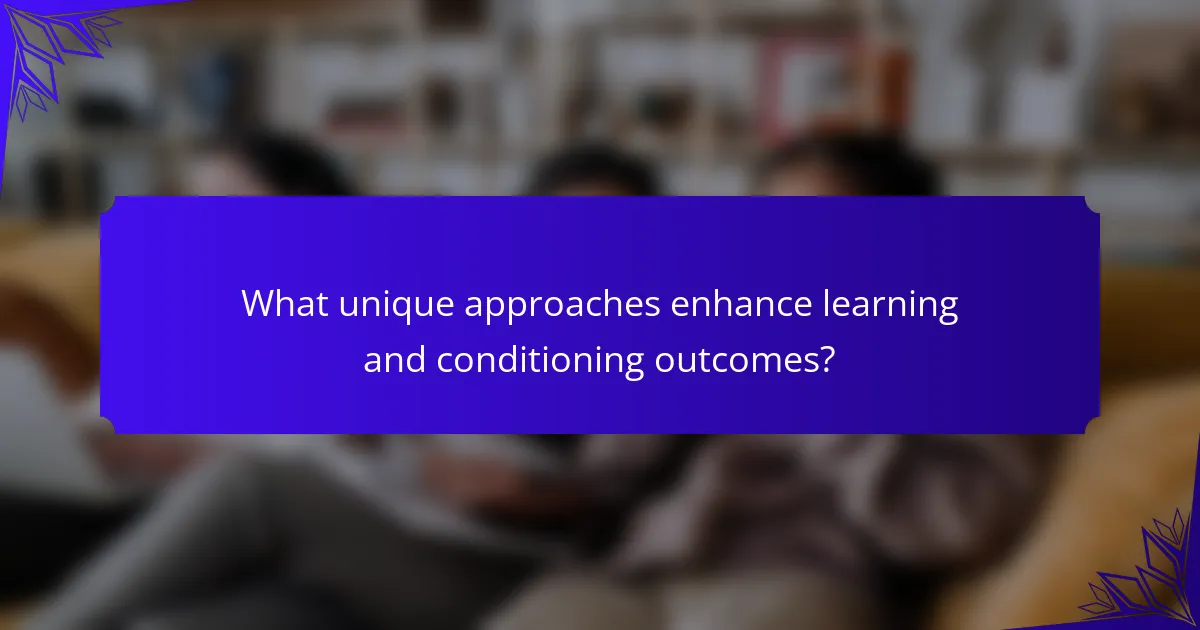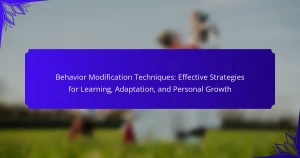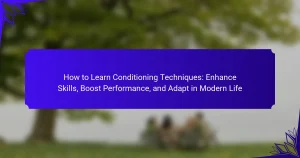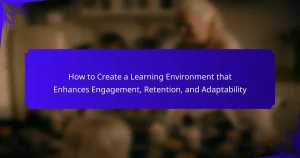Effective skill development and behavioural change are achievable through various learning and conditioning techniques. Key methods include operant conditioning, classical conditioning, observational learning, and deliberate practice. Incorporating principles like active engagement, feedback, and reinforcement enhances retention and adaptability. Current trends emphasise personalised approaches, technology integration, and experiential learning for improved outcomes.

What are the key learning and conditioning techniques for skill development?
Effective skill development utilises various learning and conditioning techniques. Key methods include operant conditioning, classical conditioning, observational learning, and deliberate practice.
Operant conditioning reinforces desired behaviours through rewards and consequences, enhancing motivation. Classical conditioning pairs new skills with established responses, facilitating easier learning. Observational learning allows individuals to acquire skills by watching others, promoting quicker adaptation. Deliberate practice focuses on targeted improvement through repetition and feedback, essential for mastering complex skills.
Incorporating these techniques can lead to significant behavioural change and skill enhancement.
How does classical conditioning influence learning?
Classical conditioning significantly influences learning by establishing associations between stimuli, enhancing skill acquisition and behavioural change. This technique involves pairing a neutral stimulus with an unconditioned stimulus to elicit a conditioned response. For instance, in educational settings, rewards can reinforce desired behaviours, leading to improved learning outcomes. The effectiveness of classical conditioning lies in its ability to create automatic responses to specific cues, facilitating quicker mastery of skills. As a result, learners can adapt their behaviours based on environmental signals, making this approach a powerful tool in skill development.
What role does operant conditioning play in behaviour modification?
Operant conditioning significantly influences behaviour modification by reinforcing desired behaviours through rewards and discouraging unwanted behaviours through punishments. This technique is effective in various contexts, including education and therapy. For example, positive reinforcement can enhance learning outcomes by encouraging skill development. The unique attribute of operant conditioning lies in its ability to create lasting behavioural changes by systematically applying consequences. As a result, individuals learn to associate specific actions with rewards or penalties, shaping their behaviour over time.
Which cognitive-behavioural strategies enhance skill acquisition?
Cognitive-behavioural strategies that enhance skill acquisition include goal setting, self-monitoring, and positive reinforcement. Goal setting provides clear objectives, while self-monitoring encourages awareness of progress. Positive reinforcement boosts motivation and reinforces desired behaviours. These strategies foster effective learning and behavioural change.

What are the universal principles of effective learning and conditioning?
Effective learning and conditioning rely on principles such as active engagement, feedback, and reinforcement. These principles enhance skill development and promote lasting behavioural change.
Active engagement encourages learners to participate fully, leading to better retention. Feedback provides essential information on performance, allowing for adjustments and improvements. Reinforcement strengthens desired behaviours, making them more likely to recur.
Additionally, the principle of spaced repetition optimises learning by distributing practice over time, enhancing long-term memory retention. The use of varied practice conditions can also improve adaptability and skill transfer.
Incorporating these principles into learning strategies fosters a more effective and rewarding educational experience, ultimately facilitating personal and professional growth.
What are the core characteristics of effective reinforcement?
Effective reinforcement is characterised by immediacy, consistency, and specificity. Immediacy ensures that reinforcement follows the desired behaviour closely, enhancing the connection between action and outcome. Consistency involves applying reinforcement uniformly to establish clear expectations. Specificity refers to clearly identifying which behaviour is being reinforced, allowing for better understanding and replication. These core characteristics foster an environment conducive to skill development and behavioural change.
How does feedback impact skill development?
Feedback significantly enhances skill development by providing essential insights for improvement. Constructive feedback identifies strengths and weaknesses, guiding learners to adjust their techniques effectively. Regular feedback fosters a growth mindset, encouraging persistence and resilience. Studies show that timely feedback can increase learning retention by 20-30%, making it a crucial element in learning and conditioning techniques.
What is the significance of practice and repetition?
Practice and repetition are crucial for skill development and behavioural change as they reinforce learning and enhance retention. Regular engagement with a task solidifies neural pathways, making the skill more automatic. This process is supported by the principle of spaced repetition, which optimises memory retention over time. Additionally, consistent practice leads to mastery, allowing individuals to execute skills with greater efficiency and confidence.

What unique approaches enhance learning and conditioning outcomes?
Innovative learning and conditioning approaches significantly improve skill development and behavioural change. Techniques such as gamification, experiential learning, and personalised feedback enhance engagement and retention.
Gamification incorporates game elements to motivate learners, leading to higher participation rates. Experiential learning emphasises hands-on experiences, fostering deeper understanding and application of skills. Personalised feedback tailors learning experiences to individual needs, promoting growth and adaptability.
These unique approaches leverage intrinsic motivation, social interaction, and real-world application, resulting in effective learning outcomes.
How do gamification techniques improve engagement in learning?
Gamification techniques significantly enhance engagement in learning by incorporating game-like elements into educational contexts. These techniques foster motivation through rewards, competition, and interactive experiences.
For example, incorporating points, badges, and leaderboards can encourage learners to participate actively and persist through challenges. Research indicates that gamified learning environments can increase retention rates by up to 50%, showcasing their effectiveness.
Moreover, gamification promotes immediate feedback, allowing learners to understand their progress in real time. This instant gratification reinforces positive behaviour and motivates continued effort.
Overall, gamification techniques transform traditional learning into an engaging experience, driving skill development and behavioural change effectively.
What are the benefits of personalised learning experiences?
Personalised learning experiences enhance engagement, retention, and motivation. They cater to individual learning styles and pace, leading to improved outcomes. Customised feedback and assessments further support skill development. Research indicates that personalised approaches can increase knowledge retention by up to 30%.

What rare attributes can influence learning and conditioning success?
Rare attributes that can influence learning and conditioning success include individual motivation, environmental context, and cognitive flexibility. These factors uniquely shape how effectively skills are developed and behaviours are changed. Individual motivation drives engagement, while environmental context provides essential cues and reinforcement. Cognitive flexibility allows for adaptation and problem-solving, enhancing the learning process.
How does emotional intelligence affect learning and behaviour change?
Emotional intelligence significantly enhances learning and behaviour change by improving self-awareness and social skills. Individuals with high emotional intelligence can better manage their emotions, leading to more effective learning environments. This ability fosters resilience, adaptability, and motivation, which are crucial for skill development. Studies show that emotional intelligence correlates with improved academic performance and better interpersonal relationships, facilitating positive behaviour change. By recognising and regulating emotions, learners can engage more deeply with content, leading to lasting behavioural shifts.
What is the impact of neuroplasticity on skill acquisition?
Neuroplasticity significantly enhances skill acquisition by allowing the brain to reorganise and adapt through learning experiences. This flexibility enables individuals to develop new skills more effectively and efficiently.
Research indicates that engaging in repetitive practice and exposure to new challenges fosters neural connections, which are crucial for mastering skills. For example, studies show that musicians exhibit increased grey matter in brain regions associated with motor control and auditory processing, illustrating the tangible impact of neuroplasticity on skill development.
Moreover, neuroplasticity facilitates the retention of learned skills over time. When individuals practice skills consistently, the brain strengthens relevant neural pathways, making it easier to retrieve and apply these skills in various contexts.
In summary, neuroplasticity plays a vital role in skill acquisition by promoting brain adaptability, enhancing learning efficiency, and solidifying skill retention.

What are the current trends in learning and conditioning in the modern world?
Current trends in learning and conditioning emphasise personalised approaches, technology integration, and experiential learning. These techniques enhance skill development and facilitate behavioural change effectively.
Personalised learning adapts to individual needs, utilising data analytics to tailor educational experiences. This approach increases engagement and retention rates.
Technology integration, including virtual reality and gamification, creates immersive environments for learners. These tools enhance motivation and allow for practical application of skills in simulated settings.
Experiential learning focuses on hands-on experiences, encouraging learners to engage actively. This method fosters critical thinking and problem-solving abilities, essential for real-world applications.
Finally, collaborative learning promotes social interaction, allowing learners to share knowledge and perspectives. This trend supports the development of interpersonal skills, crucial in today’s interconnected world.
How are technology and digital tools transforming learning experiences?
Technology and digital tools are revolutionising learning experiences by enhancing engagement, personalisation, and accessibility. Interactive platforms and adaptive learning technologies cater to individual learning styles, improving retention and skill acquisition.
Gamification techniques, such as rewards and challenges, increase motivation and participation. Virtual and augmented reality provide immersive environments, allowing learners to practice skills in realistic settings. Data analytics track progress, offering tailored feedback for continuous improvement.
As a result, these innovations foster effective skill development and behavioural change, making learning more effective and enjoyable.
What role do social learning environments play in skill development?
Social learning environments significantly enhance skill development by facilitating observation, imitation, and interaction. These environments encourage learners to engage with peers, fostering collaboration and knowledge sharing. As a result, individuals can acquire complex skills more effectively than through solitary study. Research indicates that social learning can accelerate behavioural change, making it a unique attribute of modern educational practices. Additionally, the presence of mentors in these environments provides guidance and feedback, further enriching the learning experience.

What are best practices for implementing learning and conditioning techniques?
To implement learning and conditioning techniques effectively, focus on consistency, reinforcement, and adaptability. Establish clear objectives to guide the learning process. Utilise positive reinforcement to encourage desired behaviours, while gradually introducing challenges to promote skill development. Regularly assess progress and adjust techniques based on feedback to ensure continued engagement and effectiveness.
How can individuals optimise their learning strategies?
Individuals can optimise their learning strategies by employing active learning techniques and self-regulation practices. Active learning enhances engagement and retention through methods like summarisation and teaching others. Self-regulation involves setting specific goals, monitoring progress, and adjusting strategies based on feedback.
Incorporating spaced repetition can significantly improve long-term retention of information. This technique leverages intervals between review sessions to reinforce memory. Additionally, utilising varied learning resources, such as videos and interactive tools, caters to different learning styles and keeps the process dynamic.
Mindfulness practices can also enhance focus and cognitive flexibility, allowing individuals to adapt their learning approaches as needed. Combining these strategies fosters a more effective learning environment, ultimately leading to better skill development and behavioural change.
What common mistakes should be avoided in behaviour modification?
To avoid common mistakes in behaviour modification, focus on setting clear, achievable goals. Failing to do so can lead to frustration and disengagement. Another mistake is neglecting to track progress, which is essential for maintaining motivation. Additionally, using inconsistent reinforcement can confuse the individual and hinder learning. Lastly, overlooking the individual’s unique needs and preferences can result in ineffective strategies.
What expert insights can guide effective skill development?
Effective skill development relies on structured learning and conditioning techniques. Experts recommend setting clear goals, utilising feedback loops, and embracing deliberate practice. These strategies enhance retention and promote behavioural change. Research indicates that consistent practice over time leads to mastery, with a focus on specific skills yielding the best results. Engaging in reflective learning helps identify areas for improvement, creating a cycle of continuous growth.


